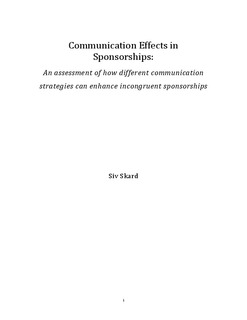Communication effects in sponsorships : an assessment of how different communication strategies can enhance incongruent sponsorships
Doctoral thesis
Permanent lenke
http://hdl.handle.net/11250/164354Utgivelsesdato
2010Metadata
Vis full innførselSamlinger
Sammendrag
Collateral communication of sponsorships is considered a prerequisite for sponsorship
success. Sponsorship is a communication form that is passive and indirect by nature and is
therefore increasingly leveraged with additional communication effort through more active
channels. This dissertation focuses on traditional advertising as a sponsorship leverage tool.
Compared to sponsorship, advertising offers a more controlled communication environment.
Thus, communicating a sponsorship through advertising means that the sponsorship message
appears as more direct, explicit, and persuasive. In general, little is known about how
consumers process sponsorship information, and even less about how sponsorships are
processed when they are presented through controlled communication channels. Based on the
commonly held notion that fit between sponsor and sponsee is associated with positive
consumer responses, the dissertation proposes that communication may improve incongruent
sponsorships through the ability to enhance perceptions of fit. By suggesting that strategic
communication can influence fit perceptions, the dissertation adapts to the conceptualization
of fit as a malleable construct.
Two experiments were conducted to investigate effects of communication on consumers’
responses to incongruent sponsorships. Based on persuasion theory, a distinction was made
between open-ended and closed-ended communication. An open-ended message, labeled
implicit communication strategy, subtly implies the basis of sponsorship fit, whereas a
closed-ended message, labeled explicit communication strategy, states the basis of
sponsorship fit directly. Results from the two experiments show an overall advantage of the
implicit strategy. Positive effects on attitude toward the sponsoring brand for this strategy
were mediated by brand image, sponsorship attitude, and altruistic motive attribution.
Contrary to the predictions, perceived fit was not identified as a key processing mechanism
for implicit communication. The explicit strategy was more effective in enhancing perceived
fit, which along with sponsorship attitude had a positive indirect effect on brand attitudes.
However, there were no overall positive effects of explicit message arguments on brand
attitudes, suggesting alternative mechanisms working in the opposite direction and cancelling
out positive total effects.
This dissertation combines theory on schema congruity and indirect persuasion with existing
sponsorship theory in order to make predictions about communication effects on incongruent
sponsorships. Recently, sponsorship researchers have recognized the opportunity of
enhancing an incongruent sponsorship through articulation of the relationship between the
sponsor and the sponsee. However, there is a lack of research into what type of information is
most effective in this regard. The research in this dissertation bridges this knowledge gap by
testing two distinct approaches to sponsorship communication. Moreover, no research has
examined communication effects at different levels of sponsorship incongruency. As an
attempt to fill this gap, the dissertation provides a test of communication effects for strong
versus moderate sponsorship incongruency. The research offers practical recommendations
with respect to how incongruent sponsorships should be communicated. Theoretically, it
contributes to the understanding of how a sponsorship message is processed, to the
conceptualization of perceived fit, and to theory of indirect persuasion.
Utgiver
Norwegian School of Economics and Business AdministrationSerie
Ph.D. thesis NHH2010:7
